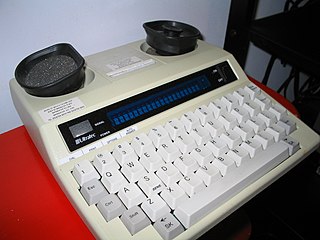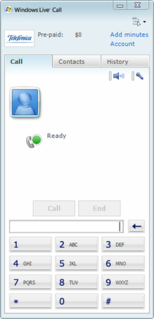Related Research Articles

A telephone is a telecommunications device that permits two or more users to conduct a conversation when they are too far apart to be heard directly. A telephone converts sound, typically and most efficiently the human voice, into electronic signals that are transmitted via cables and other communication channels to another telephone which reproduces the sound to the receiving user. The term is derived from Greek: τῆλε and φωνή, together meaning distant voice. A common short form of the term is phone, which came into use almost immediately after the first patent was issued.
Interactive voice response (IVR) is a technology that allows humans to interact with a computer-operated phone system through the use of voice and DTMF tones input via a keypad. In telecommunications, IVR allows customers to interact with a company’s host system via a telephone keypad or by speech recognition, after which services can be inquired about through the IVR dialogue. IVR systems can respond with pre-recorded or dynamically generated audio to further direct users on how to proceed. IVR systems deployed in the network are sized to handle large call volumes and also used for outbound calling as IVR systems are more intelligent than many predictive dialer systems.
A ringtone or ring tone is the sound made by a telephone to indicate an incoming call or text message. Not literally a tone nor an actual (bell-like) ring anymore, the term is most often used today to refer to customizable sounds used on mobile phones.

The answering machine, answerphone or message machine, also known as telephone messaging machine in the UK and some Commonwealth countries, ansaphone or ansafone, or telephone answering device (TAD), is used for answering telephones and recording callers' messages. If a phone rings a predetermined number of times by the phone's owner, and nobody is present to answer the incoming call, the answering machine will activate and play either a generic announcement or the voice of the person being called announcing that nobody is able to come to the phone at the moment. Following the announcement is a beeping tone which prompts the caller to record his or her message after the tone concludes.
A voicemail system is a computer-based system that allows users and subscribers to exchange personal voice messages; to select and deliver voice information; and to process transactions relating to individuals, organizations, products, and services, using an ordinary phone. The term is also used more broadly to denote any system of conveying a stored telecommunications voice messages, including using an answering machine. Most cell phone services offer voicemail as a basic feature; many corporate private branch exchanges include versatile internal voice-messaging services, and *98 vertical service code subscription is available to most individual and small business landline subscribers.

A telecommunications device for the deaf (TDD) is a teleprinter, an electronic device for text communication over a telephone line, that is designed for use by persons with hearing or speech difficulties. Other names for the device include teletypewriter (TTY), textphone, and minicom.

A telephone call is a connection over a telephone network between the called party and the calling party.
Phone fraud, or more generally communications fraud, is the use of telecommunications products or services with the intention of illegally acquiring money from, or failing to pay, a telecommunication company or its customers.

The Carterfone is a device invented by Thomas Carter. It manually connects a two-way radio system to the telephone system, allowing someone on the radio to talk to someone on the phone. This makes it a direct predecessor to today's autopatch.

A business telephone system is a multiline telephone system typically used in business environments, encompassing systems ranging in technology from the key telephone system (KTS) to the private branch exchange (PBX).
GSM services are a standard collection of applications and features available over the Global System for Mobile Communications (GSM) to mobile phone subscribers all over the world. The GSM standards are defined by the 3GPP collaboration and implemented in hardware and software by equipment manufacturers and mobile phone operators. The common standard makes it possible to use the same phones with different companies' services, or even roam into different countries. GSM is the world's most dominant mobile phone standard.
An SMS gateway or MMS gateway allows a computer to send or receive text messages in the form of Short Message Service (SMS) or Multimedia Messaging Service (MMS) transmissions between local and/or international telecommunications networks. In most cases, SMS and MMS are eventually routed to a mobile phone through a wireless carrier. SMS gateways are commonly used as a method for person-to-person to device-to-person communications. Many SMS gateways support content and media conversions from email, push, voice, and other formats.
Mobile VoIP or simply mVoIP is an extension of mobility to a Voice over IP network. Two types of communication are generally supported: cordless/DECT/PCS protocols for short range or campus communications where all base stations are linked into the same LAN, and wider area communications using 3G/4G protocols.
Voice phishing is a form of criminal phone fraud, using social engineering over the telephone system to gain access to private personal and financial information for the purpose of financial reward. It is sometimes referred to as "vishing," a portmanteau of "voice" and "phishing."

AT&T Merlin is a corporate telephone system by American Telephone and Telegraph (AT&T) that was introduced in late 1983, when it was branded American Bell Merlin. After the breakup of AT&T in 1984, it was rebranded and later also supplied by Lucent, and Avaya.
CT2 is a cordless telephony standard that was used in the early 1990s to provide short-range proto-mobile phone service in some countries in Europe. It is considered the precursor to the more successful DECT system. CT2 was also referred to by its marketing name, Telepoint.

Windows Live Call was part of Microsoft's Windows Live services. It integrated into Windows Live Messenger to allow users to make PC-to-PC and PC-to-Phone voice and video calls. Microsoft partnered with telecommunication companies around the world to allow users to use a PC equipped with a microphone and speakers and a high speed Internet connection to call almost any regular telephone anywhere in the world.
Windows Speech Recognition (WSR) is speech recognition developed by Microsoft for Windows Vista that enables voice commands to control the desktop user interface; dictate text in electronic documents and email; navigate websites; perform keyboard shortcuts; and to operate the mouse cursor. It supports custom macros to perform additional or supplementary tasks.
Unified communications (UC) is a business and marketing concept describing the integration of enterprise communication services such as instant messaging (chat), presence information, voice, mobility features, audio, web & video conferencing, fixed-mobile convergence (FMC), desktop sharing, data sharing, call control and speech recognition with non-real-time communication services such as unified messaging. UC is not necessarily a single product, but a set of products that provides a consistent unified user interface and user experience across multiple devices and media types.

A headset combines a headphone with microphone. Headsets are made with either a single-earpiece (mono) or a double-earpiece. Headsets provide the equivalent functionality of a telephone handset but with handsfree operation. They have many uses including in call centers and other telephone-intensive jobs and for anybody wishing to have both hands free during a telephone conversation.
References
- 1 2 3 4 Lewis, Peter (November 5, 1998). "Microsoft Offers a Telephone to Work With PCs". The New York Times . The New York Times Company . Retrieved May 4, 2015.
- 1 2 3 4 5 Microsoft (October 6, 1998). "Microsoft Brings the Power of the PC to the Telephone With New Cordless Phone System". News Center. Retrieved May 5, 2015.
- ↑ Microsoft (November 4, 1998). "Microsoft Dials in to the Telephone Market". News Center. Retrieved May 4, 2015.
- ↑ Smith, Tony (October 6, 1998). "Microsoft unveils cordless phone". The Register . Situation Publishing. Retrieved May 5, 2015.
- ↑ Microsoft. "Microsoft Cordless Phone System". Archived from the original on May 8, 1999. Retrieved May 11, 2015.
- ↑ Thurrott, Paul (October 5, 1998). "Microsoft prepares entry into phone market". Supersite for Windows. Penton . Retrieved May 5, 2015.
- ↑ "Microsoft Cordless Phone System". TMC Labs. Technology Marketing Corporation. 1999. Retrieved May 5, 2015.
- ↑ Schulman, Jerold (October 24, 2000). "JSI Tip 2952. When you install Microsoft Cordless Phone PC Phone System on Windows 2000, you receive an error message?". Windows IT Pro. Penton . Retrieved May 11, 2015.